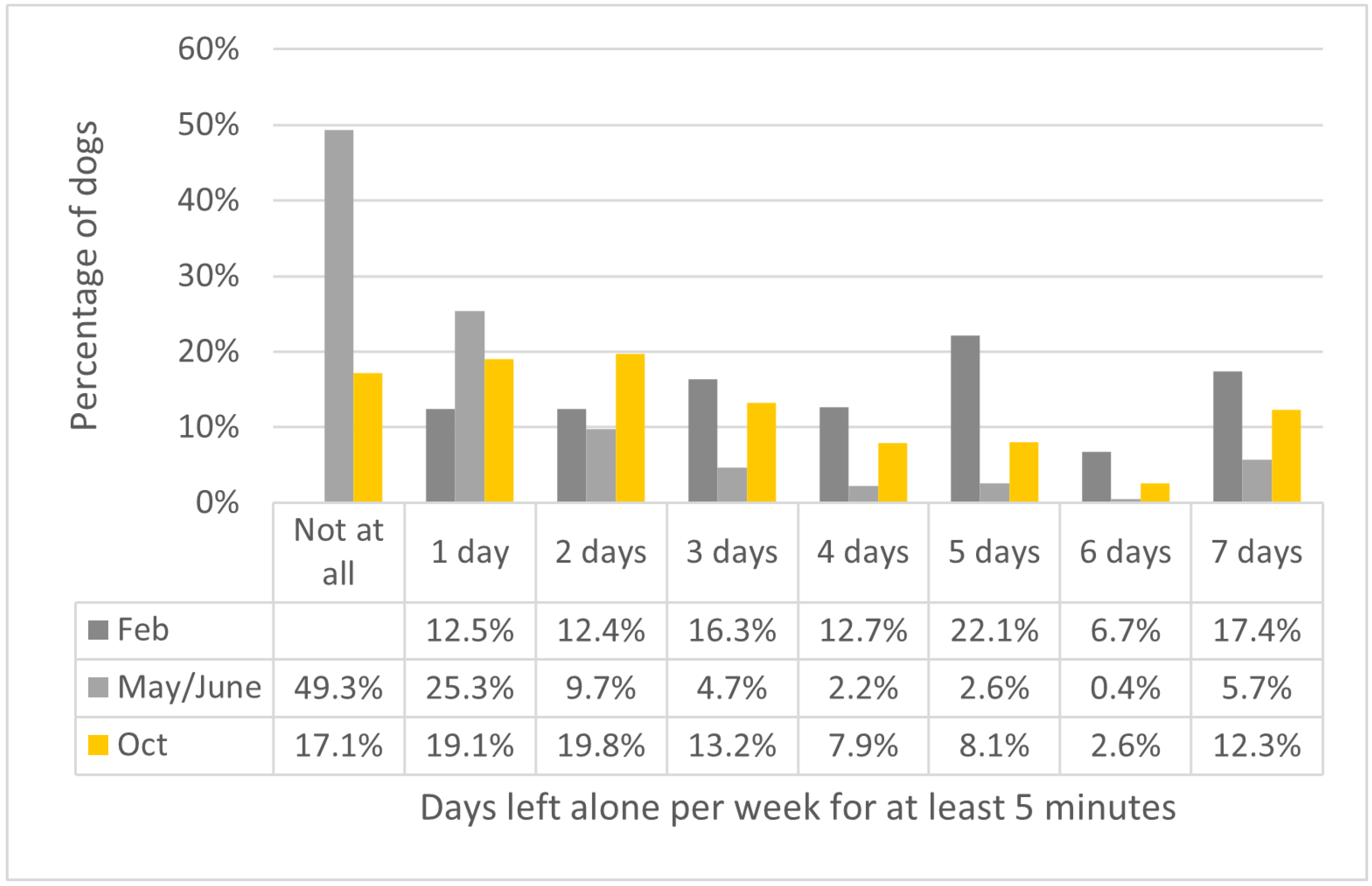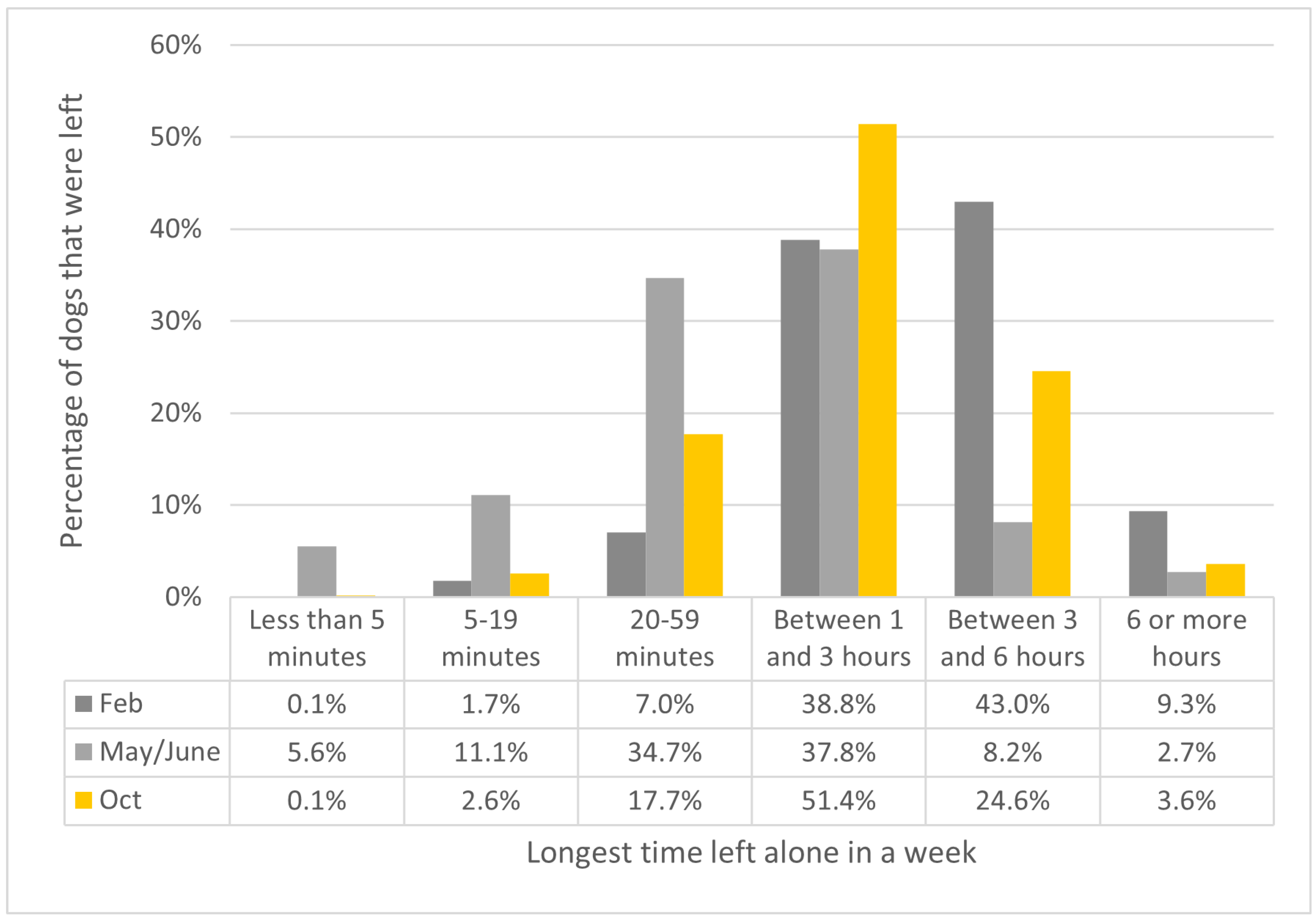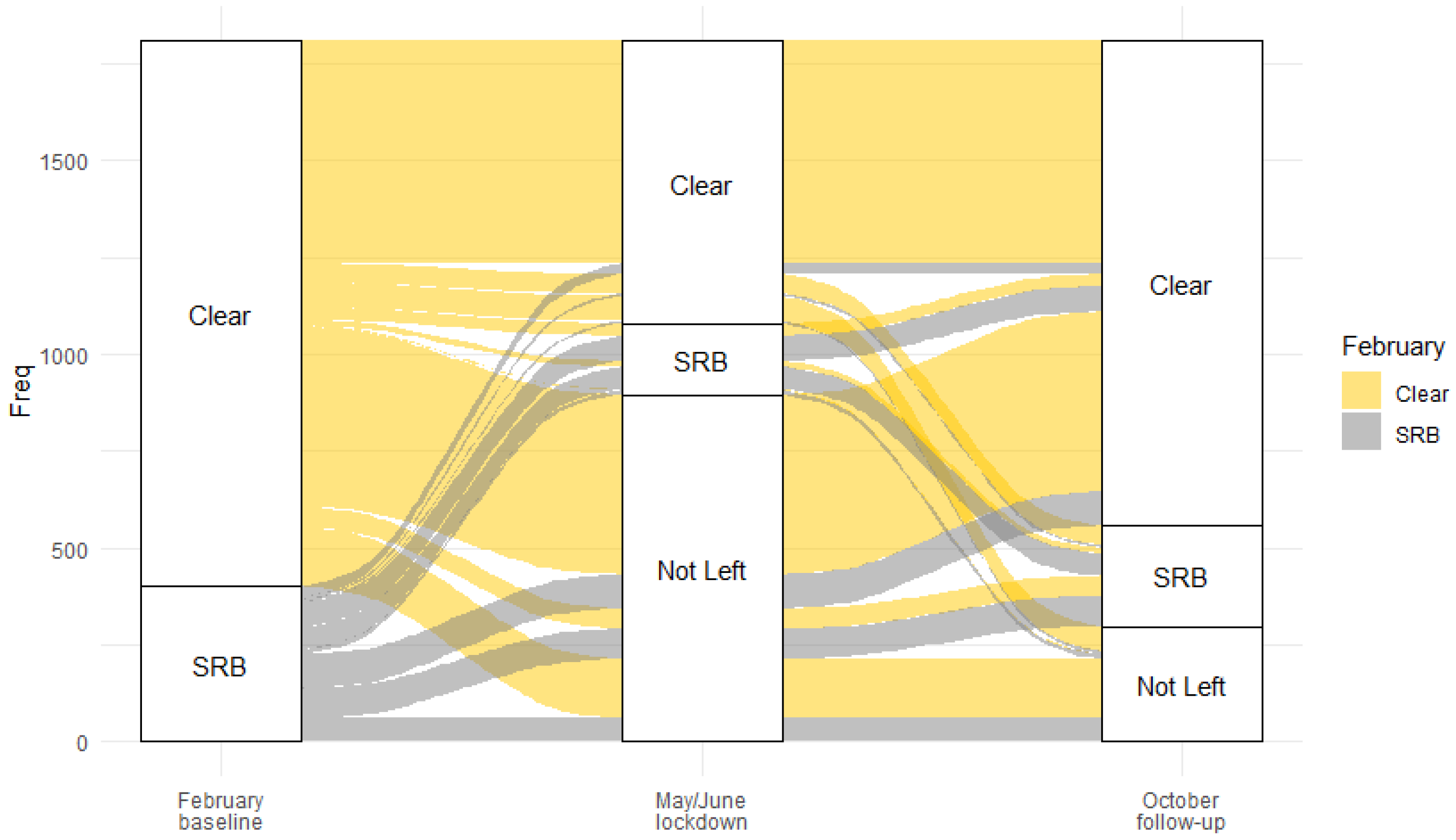Impact of Changes in Time Left Alone on Separation-Related Behaviour in UK Pet Dogs
Abstract
:Simple Summary
Abstract
1. Introduction
2. Materials and Methods
2.1. Study Subjects
2.2. The Surveys
2.3. Quantitative Analysis
2.4. Qualitative Analysis
3. Results
3.1. Days Left Alone per Week for at Least 5 Min
3.2. Longest Time Left Alone
3.3. SRB Status
3.4. Factors Associated with Development of SRB Signs
3.5. Factors Associated with Resolution of SRB Signs
3.6. Qualitative Analysis
3.6.1. Inter-Rater Coding Agreement
3.6.2. How Dogs’ SRB had Changed
3.6.3. ‘Other’ Separation-Linked Behaviour
4. Discussion
5. Conclusions
Supplementary Materials
Author Contributions
Funding
Institutional Review Board Statement
Informed Consent Statement
Data Availability Statement
Acknowledgments
Conflicts of Interest
References
- De Assis, L.S.; Matos, R.; Pike, T.W.; Burman, O.H.P.; Mills, D.S. Developing Diagnostic Frameworks in Veterinary Behavioral Medicine: Disambiguating Separation Related Problems in Dogs. Front. Vet. Sci. 2020, 6, 499. [Google Scholar] [CrossRef] [PubMed] [Green Version]
- Palestrini, C.; Minero, M.; Cannas, S.; Rossi, E.; Frank, D. Video analysis of dogs with separation-related behaviors. Appl. Anim. Behav. Sci. 2010, 124, 61–67. [Google Scholar] [CrossRef] [Green Version]
- Blackwell, E.; Casey, R.A.; Bradshaw, J.W.S. Controlled trial of behavioural therapy for separation-related disorders in dogs. Vet. Rec. 2006, 158, 551–554. [Google Scholar] [CrossRef] [PubMed]
- McCrave, E.A. Diagnostic criteria for separation anxiety in the dog. Vet. Clin. North Am. Small Anim. Pract. 1991, 21, 247–255. [Google Scholar] [CrossRef]
- Overall, K. Manual of Clinical Behavioral Medicine for Dogs and Cats; Mosby Elsevier Inc.: St. Louis, MO, USA, 2013. [Google Scholar]
- Sherman, B.L.; Mills, D.S. Canine Anxieties and Phobias: An Update on Separation Anxiety and Noise Aversions. Vet. Clin. North Am.—Small Anim. Pract. 2008, 38, 1081–1106. [Google Scholar] [CrossRef] [PubMed]
- Siracusa, C.; Provoost, L.; Reisner, I.R. Dog- and owner-related risk factors for consideration of euthanasia or rehoming before a referral behavioral consultation and for euthanizing or rehoming the dog after the consultation. J. Vet. Behav. Clin. Appl. Res. 2017, 22, 46–56. [Google Scholar] [CrossRef]
- Tiira, K.; Sulkama, S.; Lohi, H. Prevalence, comorbidity, and behavioral variation in canine anxiety. J. Vet. Behav. Clin. Appl. Res. 2016, 16, 36–44. [Google Scholar] [CrossRef]
- Salonen, M.; Sulkama, S.; Mikkola, S.; Puurunen, J.; Hakanen, E.; Tiira, K.; Araujo, C.; Lohi, H. Prevalence, comorbidity, and breed differences in canine anxiety in 13,700 Finnish pet dogs. Sci. Rep. 2020, 10, 2962. [Google Scholar] [CrossRef] [Green Version]
- Horowitz, D. Separation-related behaviours in dogs and cats. In BSAVA Manual of Canine and Feline Behavioural Medicine; Horowitz, D., Mills, D., Eds.; BSAVA: Gloucester, UK, 2017; pp. 211–222. [Google Scholar]
- Bradshaw, J.W.S.; McPherson, J.A.; Casey, R.A.; Larter, I.S. Aetiology of separation-related behaviour in domestic dogs. Vet. Rec. 2002, 151, 43–46. [Google Scholar] [CrossRef]
- Karagiannis, C.I.; Burman, O.H.P.; Mills, D.S. Dogs with separation-related problems show a “less pessimistic” cognitive bias during treatment with fluoxetine (ReconcileTM) and a behaviour modification plan. BMC Vet. Res. 2015, 11, 80. [Google Scholar] [CrossRef] [Green Version]
- Blackwell, E.J.; Casey, R.A.; Bradshaw, J.W.S. Efficacy of written behavioral advice for separation-related behavior problems in dogs newly adopted from a rehoming center. J. Vet. Behav. 2016, 12, 13–19. [Google Scholar] [CrossRef]
- Butler, R.; Sargisson, R.J.; Elliffe, D. The efficacy of systematic desensitization for treating the separation-related problem behaviour of domestic dogs. Appl. Anim. Behav. Sci. 2011, 129, 136–145. [Google Scholar] [CrossRef]
- Blackwell, E.J.; Bradshaw, J.W.S.; Casey, R.A. Preventing separation problems in re-homed dogs: Improving owner compliance. J. Vet. Behav. 2010, 5, 23–24. [Google Scholar] [CrossRef]
- Bowen, J.; García, E.; Darder, P.; Argüelles, J.; Fatjó, J. The effects of the Spanish COVID-19 lockdown on people, their pets, and the human-animal bond. J. Vet. Behav. 2020, 40, 75–91. [Google Scholar] [CrossRef] [PubMed]
- Christley, R.M.; Murray, J.K.; Anderson, K.L.; Buckland, E.L.; Casey, R.A.; Harvey, N.D.; Harris, L.; Holland, K.E.; McMillan, K.M.; Mead, R.; et al. Impact of the first COVID-19 lockdown on management of pet dogs in the UK. Animals 2021, 11, 5. [Google Scholar] [CrossRef] [PubMed]
- Hargrave, C. COVID-19: Implications of self-isolation and social distancing for the emotional and behavioural health of dogs. Companion Anim. 2020, 25, 1–8. [Google Scholar] [CrossRef]
- Dogs Trust. The Impact of COVID-19 Lockdown Restrictions on Dogs & Dog Owners in the UK; Dogs Trust: London, UK, 2020. [Google Scholar]
- Holland, K.E.; Owczarczak-Garstecka, S.C.; Anderson, K.L.; Casey, R.A.; Christley, R.M.; Harris, L.; McMillan, K.M.; Mead, R.; Murray, J.K.; Samet, L.; et al. “More Attention than Usual”: A Thematic Analysis of Dog Ownership Experiences in the UK during the First COVID-19 Lockdown. Animals 2021, 11, 240. [Google Scholar] [CrossRef]
- Shoesmith, E.; Shahab, L.; Kale, D.; Mills, D.S.; Reeve, C.; Toner, P.; de Assis, L.S.; Ratschen, E. The Influence of Human–Animal Interactions on Mental and Physical Health during the First COVID-19 Lockdown Phase in the U.K.: A Qualitative Exploration. Int. J. Environ. Res. Public Health 2021, 18, 976. [Google Scholar] [CrossRef]
- Bussolari, C.; Currin-Mcculloch, J.; Packman, W.; Kogan, L.; Erdman, P. “I Couldn’t Have Asked for a Better Quarantine Partner!”: Experiences with Companion Dogs during Covid-19. Animals 2021, 11, 330. [Google Scholar] [CrossRef]
- R Core Team. R: A Language and Environment for Statistical Computing; R Foundation for Statistical Computing: Vienna, Austria, 2021. [Google Scholar]
- RStudio Team. RStudio: Integrated Development for R; 2020. [Google Scholar]
- Dogs Trust. How to Help Your Dog Get Used to Spending Time Alone. Available online: https://www.dogstrust.org.uk/help-advice/training/help-your-dog-enjoy-time-alone (accessed on 23 September 2021).
- Pineda, M.H.; Dooley, M.P. McDonald’s Veterinary Endocrinology and Reproduction; Iowa State Press: Ames, IA, USA, 2003; ISBN 9780813811062. [Google Scholar]
- Jackman, S. pscl: Classes and Methods for R Developed in the Political Science Computational Laboratory. United States Studies Centre, University of Sydney. 2020. [Google Scholar]
- Flannigan, G.; Dodman, N.H. Risk factors and behaviors associated with separation anxiety in dogs. J. Am. Vet. Med. Assoc. 2001, 219, 460–466. [Google Scholar] [CrossRef] [Green Version]
- van Rooy, D.; Arnott, E.R.; Thomson, P.C.; McGreevy, P.D.; Wade, C.M. Using an owner-based questionnaire to phenotype dogs with separation-related distress: Do owners know what their dogs do when they are absent? J. Vet. Behav. Clin. Appl. Res. 2018, 23, 58–65. [Google Scholar] [CrossRef]
- Mendl, M.; Brooks, J.; Basse, C.; Burman, O.; Paul, E.; Blackwell, E.; Casey, R. Dogs showing separation-related behaviour exhibit a “pessimistic” cognitive bias. Curr. Biol. 2010, 20, R839–R840. [Google Scholar] [CrossRef] [Green Version]
- Marx, A.; Lenkei, R.; Fraga, P.P.; Wallis, L.; Kubinyi, E.; Faragó, T. Age-dependent changes in dogs’ (Canis familiaris) separation-related behaviours in a longitudinal study. Appl. Anim. Behav. Sci. 2021, 242, 105422. [Google Scholar] [CrossRef]
- Mongillo, P.; Pitteri, E.; Carnier, P.; Gabai, G.; Adamelli, S.; Marinelli, L. Does the attachment system towards owners change in aged dogs? Physiol. Behav. 2013, 120, 64–69. [Google Scholar] [CrossRef] [PubMed]
- van Rooy, D.; Thomson, P.C.; McGreevy, P.D.; Wade, C.M. Risk factors of separation-related behaviours in Australian retrievers. Appl. Anim. Behav. Sci. 2018, 209, 71–77. [Google Scholar] [CrossRef]
- Lofgren, S.E.; Wiener, P.; Blott, S.C.; Sanchez-Molano, E.; Woolliams, J.A.; Clements, D.N.; Haskell, M.J. Management and personality in Labrador Retriever dogs. Appl. Anim. Behav. Sci. 2014, 156, 44–53. [Google Scholar] [CrossRef]
- McGreevy, P.D.; Masters, A.M. Risk factors for separation-related distress and feed-related aggression in dogs: Additional findings from a survey of Australian dog owners. Appl. Anim. Behav. Sci. 2008, 109, 320–328. [Google Scholar] [CrossRef]
- Serpell, J.A.; Hsu, Y. Effects of breed, sex, and neuter status on trainability in dogs. Anthrozoos 2005, 18, 196–207. [Google Scholar] [CrossRef] [Green Version]
- Stephan, G.; Leidhold, J.; Hammerschmidt, K. Pet dogs home alone: A video-based study. Appl. Anim. Behav. Sci. 2021, 244, 105463. [Google Scholar] [CrossRef]
- Harvey, N.D.; Craigon, P.J.; Blythe, S.A.; England, G.C.W.; Asher, L. Social rearing environment influences dog behavioral development. J. Vet. Behav. Clin. Appl. Res. 2016, 16, 13–21. [Google Scholar] [CrossRef]
- King, J.N.; Simpson, B.S.; Overall, K.L.; Appleby, D.; Pageat, P.; Ross, C.; Chaurand, J.P.; Heath, S.; Beata, C.; Weiss, A.B.; et al. Treatment of separation anxiety in dogs with clomipramine: Results from a prospective, randomized, double-blind, placebo-controlled, parallel-group, multicenter clinical trial. Appl. Anim. Behav. Sci. 2000, 67, 255–275. [Google Scholar] [CrossRef]
- Tiira, K.; Lohi, H. Early life experiences and exercise associate with canine anxieties. PLoS ONE 2015, 10, e0141907. [Google Scholar] [CrossRef] [Green Version]
- Teixeira, A.R.; Hall, N.J. Effect of greeting and departure interactions on the development of increased separation-related behaviors in newly adopted adult dogs. J. Vet. Behav. 2021, 41, 22–32. [Google Scholar] [CrossRef]
- Dogs Trust Welfare Crisis|Dogs Trust. Available online: https://www.dogstrust.org.uk/latest/2020/dogs-trust-warns-up-to-40-000-dogs-could-be-at-risk-of-abandonment-in-the-fallout-of-the-coronavirus-crisis (accessed on 1 October 2021).
- Hanibuchi, T.; Yabe, N.; Nakaya, T. Who is staying home and who is not? Demographic, socioeconomic, and geographic differences in time spent outside the home during the COVID-19 outbreak in Japan. Prev. Med. Rep. 2021, 21, 101306. [Google Scholar] [CrossRef] [PubMed]



| Variable | Est | Std. Error | Z | p-Value | OR |
|---|---|---|---|---|---|
| SRB status during lockdown (ref: Clear) * | 1.68 | 0.35 | 4.87 | <0.001 | 5.38 |
| Sex (ref: female) * | −0.01 | 0.20 | −0.04 | 0.972 | 0.99 |
| Age | 0.12 | 0.04 | 2.86 | 0.004 | 1.13 |
| Neutered (ref: neutered) * | −0.01 | 0.30 | −0.32 | 0.749 | 0.91 |
| Difference: days alone Lockdown–Feb | −0.21 | 0.06 | −3.54 | <0.001 | 0.81 |
| Difference: days alone Oct–Lockdown | 0.01 | 0.06 | 1.48 | 0.140 | 1.10 |
| Difference: days alone Oct–Feb | −0.07 | 0.06 | −1.19 | 0.235 | 0.93 |
| Difference: Longest time alone Lockdown–Feb | −0.05 | 0.05 | −0.95 | 0.341 | 0.95 |
| Difference: Longest time alone Oct–Lockdown | −0.03 | 0.06 | −0.48 | 0.635 | 0.97 |
| Difference: Longest time alone Oct–Feb (ref: Left alone less) *^ | |||||
| No change | −0.23 | 0.20 | −1.36 | 0.174 | 0.76 |
| Left alone longer | −0.63 | 0.39 | −1.61 | 0.108 | 0.53 |
| Single or multi-dog household (ref: single) * | −0.08 | 0.22 | −0.36 | 0.722 | 0.92 |
| Variable | Est | Std. Error | Z | p-Value | OR |
|---|---|---|---|---|---|
| (Intercept) | −2.97 | 0.23 | −13.11 | <0.001 | - |
| Difference: days alone per week Lockdown–Feb | −0.22 | 0.06 | −3.45 | <0.001 | 0.80 |
| SRB+ during lockdown (ref: Clear) * | 1.60 | 2.60 | 3.60 | <0.001 | 4.97 |
| Variable | Est | Std. Error | Z | p-Value | OR |
|---|---|---|---|---|---|
| SRB status during lockdown (ref: Clear) * | 1.24 | 0.46 | 2.68 | 0.007 | 3.44 |
| Sex (ref: female) * | <0.01 | 0.23 | 0.02 | 0.986 | 1.00 |
| Age | −0.02 | 0.05 | −0.43 | 0.665 | 0.98 |
| Neutered (ref: neutered) * | −0.22 | 0.33 | −0.67 | 0.502 | 0.80 |
| Difference: days alone Lockdown–Feb | −0.04 | 0.06 | −0.64 | 0.524 | 0.97 |
| Difference: days alone Oct–Lockdown | −0.01 | 0.05 | −0.16 | 0.875 | 0.99 |
| Difference: days alone Oct–Feb | −0.06 | 0.06 | −0.10 | 0.319 | 0.95 |
| Difference: Longest time alone Lockdown–Feb | −0.12 | 0.06 | −1.96 | 0.051 | 0.89 |
| Difference: Longest time alone Oct–Lockdown | 0.12 | 0.07 | 1.88 | 0.060 | 1.13 |
| Difference: Longest time alone Oct–Feb | −0.17 | 0.137 | −1.24 | 0.216 | 0.84 |
| Single or multi-dog household (ref: single) * | 0.07 | 0.25 | 0.28 | 0.777 | 1.07 |
Publisher’s Note: MDPI stays neutral with regard to jurisdictional claims in published maps and institutional affiliations. |
© 2022 by the authors. Licensee MDPI, Basel, Switzerland. This article is an open access article distributed under the terms and conditions of the Creative Commons Attribution (CC BY) license (https://creativecommons.org/licenses/by/4.0/).
Share and Cite
Harvey, N.D.; Christley, R.M.; Giragosian, K.; Mead, R.; Murray, J.K.; Samet, L.; Upjohn, M.M.; Casey, R.A. Impact of Changes in Time Left Alone on Separation-Related Behaviour in UK Pet Dogs. Animals 2022, 12, 482. https://doi.org/10.3390/ani12040482
Harvey ND, Christley RM, Giragosian K, Mead R, Murray JK, Samet L, Upjohn MM, Casey RA. Impact of Changes in Time Left Alone on Separation-Related Behaviour in UK Pet Dogs. Animals. 2022; 12(4):482. https://doi.org/10.3390/ani12040482
Chicago/Turabian StyleHarvey, Naomi D., Robert M. Christley, Kassandra Giragosian, Rebecca Mead, Jane K. Murray, Lauren Samet, Melissa M. Upjohn, and Rachel A. Casey. 2022. "Impact of Changes in Time Left Alone on Separation-Related Behaviour in UK Pet Dogs" Animals 12, no. 4: 482. https://doi.org/10.3390/ani12040482








